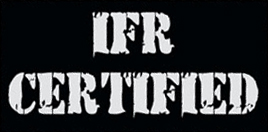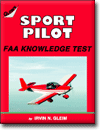|
 NIGHT - IFR in an SLSA? NIGHT - IFR in an SLSA?
EAA NEWS - 10/13/05 - SPECIAL LSA AND
NIGHT/IFR FLYING
Some confusion exists in the aviation marketplace
regarding the use of special light-sport aircraft (S-LSA) for flying at night
and/or under instrument flight rules (IFR). The ASTM consensus standards that
govern the manufacture and production of S-LSA specifically address day/visual
flight rules (VFR) operations only.
First, sport pilots, or those exercising sport pilot privileges, are restricted
from flying at night or in IFR conditions, so they may not operate an S-LSA, or
any aircraft, at those times.
Other properly rated pilots may fly an S-LSA in those conditions if allowed per
the aircraft's operating limitations and if it is equipped per FAR 91.205.
Additionally, FAR 91.327(d) requires all S-LSA to be operated in accordance with
the aircraft's operating instructions. An aircraft's operating instructions are
different from operating limitations; operating instructions are issued by
manufacturers-engine, airframe, and accessory-while operating limitations are
issued by the FAA.
When ordering an IFR aircraft, the airframe is
updated for IFR operations. This includes grounding straps for lightning
protection, Heated pitot-static tube, IFR pilot side window (small window that
opens), TSO gauges and a lot more. These items are similar to the Zenair FAA
certified CH2000 that is FAA certified for IFR operations.
Many S-LSA are equipped with Rotax engines. Rotax's operating instructions
prohibit the use of a Rotax engine at night or in IFR conditions unless it is
the FAA type-certificated engine; that is, certificated to FAR Part 33. Rotax's
non-certificated engines are indicated by the letters "UL" after the engine
series number; for example, 912UL, 912ULS, and 914UL.
The classic Continental 0-200 is FAA certified
under Part 33 and therefore can be used for IFR flying. The light weight 0-200
is LSA complient but not Part 33 certified.
Additionally, S-LSA airframe and engine manufacturers may place restrictions
against the use of their aircraft and/or engines for night/IFR operations. For
example, other S-LSA are powered by Jabiru engines; these engines are
certificated to JAR-22H and are limited to day/VFR operation.
Bottom line: some S-LSA can be equipped for night and IFR operation; be sure to
tell the manufacturer/dealer if your intent is to operate the aircraft under
those conditions...and make sure you have the proper ratings.
See the AOPA Q&A on SLSA IFR flying.
For more information, call EAA's Aviation Service at 888/EAA-INFO (322-4636) or
e-mail
info@eaa.org.


FAA's
Sport Pilot / Light Sport Aircraft (LSA)
AOPA Frequently Asked Questions About Sport Pilot
- VFR-NIGHT-IFR
http://www.aopa.org/advocacy/advocacy-briefs/frequently-asked-questions-about-sport-pilot.aspx
SPORT PILOT / LIGHT-SPORT AIRCRAFT RULE
QUICK
ANSWERS TO COMMON QUESTIONS
The following from EAA is a collection of brief answers to
some of the more common Sport Pilot questions:
-
Gross
weight = 1,320 pounds (600 kilograms)
-
Max
Continuous Full Power Speed = 120 knots (138 mph)
-
Max Stall
Speed = 45 knots (52 mph)
-
Two
Place - pilot and one passenger
-
Day
VFR
-
Driver's
License Medical Approved - however, if you have
received a letter with the word "denied" from
FAA, not from your doctor, you must get a one-time
special issuance or FAA authorization. Even if you
have been denied in the past, you can try again for
special issuance (medicines have changed, for example).
-
Rule
Effective Date =
SEPTEMBER
1, 2004
More
Details:
 |
Gleim
Publications now offers a Sport Pilot Kit designed
to help expedite training for the sport pilot
certificate. They offer a complete training program at
an affordable price, with user-friendly self-study
materials that are carefully designed to make it easy to
learn and understand.
The
Sport
Pilot Kit contains everything you need (except
airplane and instructor).
The
"sport pilot certificate" varies from existing
private pilot certificates significantly including:
1.
Requires only 20 hours of flight
instruction as compared to 40 hours for private pilot.
2.
Limits sport pilots to flying low
performance airplanes: maximum weight 1320 lbs, maximum
stall speed 45 knots, maximum speed 120 knots, fixed
landing gear, and a fixed pitch propeller.
The
objective is to make the thrill, satisfaction, and
excitement of aviation available to more people by
reducing the complexity and cost. |
|
The
Complete Idiot's Guide to Sport Flying
by Dan Ramsey,
Earl Downs, forwarded by Tom Poberezny |

|
The FAA's new sport flying license will let
people earn their wings for a fraction of the time and cost of a
traditional license. The Complete Idiot’s Guide‚ to Sport Flying
introduces this new field of flying to consumers, and shows you how to fly
smart—offering tips on how to get more flying fun for less money. |
Sport
Pilot Info:
|
If I become a sport pilot, what can I
fly?
An aircraft that meets the definition of a light-sport aircraft may hold
an airworthiness certificate in any one of the following categories of
FAA certification:
-
an experimental aircraft, including
amateur-built aircraft, for which the owner must construct more
than 51-percent of the aircraft.
-
a Standard category aircraft; that is,
a ready-to-fly aircraft that is type-certificated in accordance with
FAR Part 43.
-
a Primary category aircraft; that is,
a ready-to-fly aircraft that is type-certificated in accordance with
Primary category regulations.
-
a "special" light-sport
aircraft
-
an experimental light-sport aircraft.
|
|
|
 NIGHT - IFR in an SLSA?
NIGHT - IFR in an SLSA?


